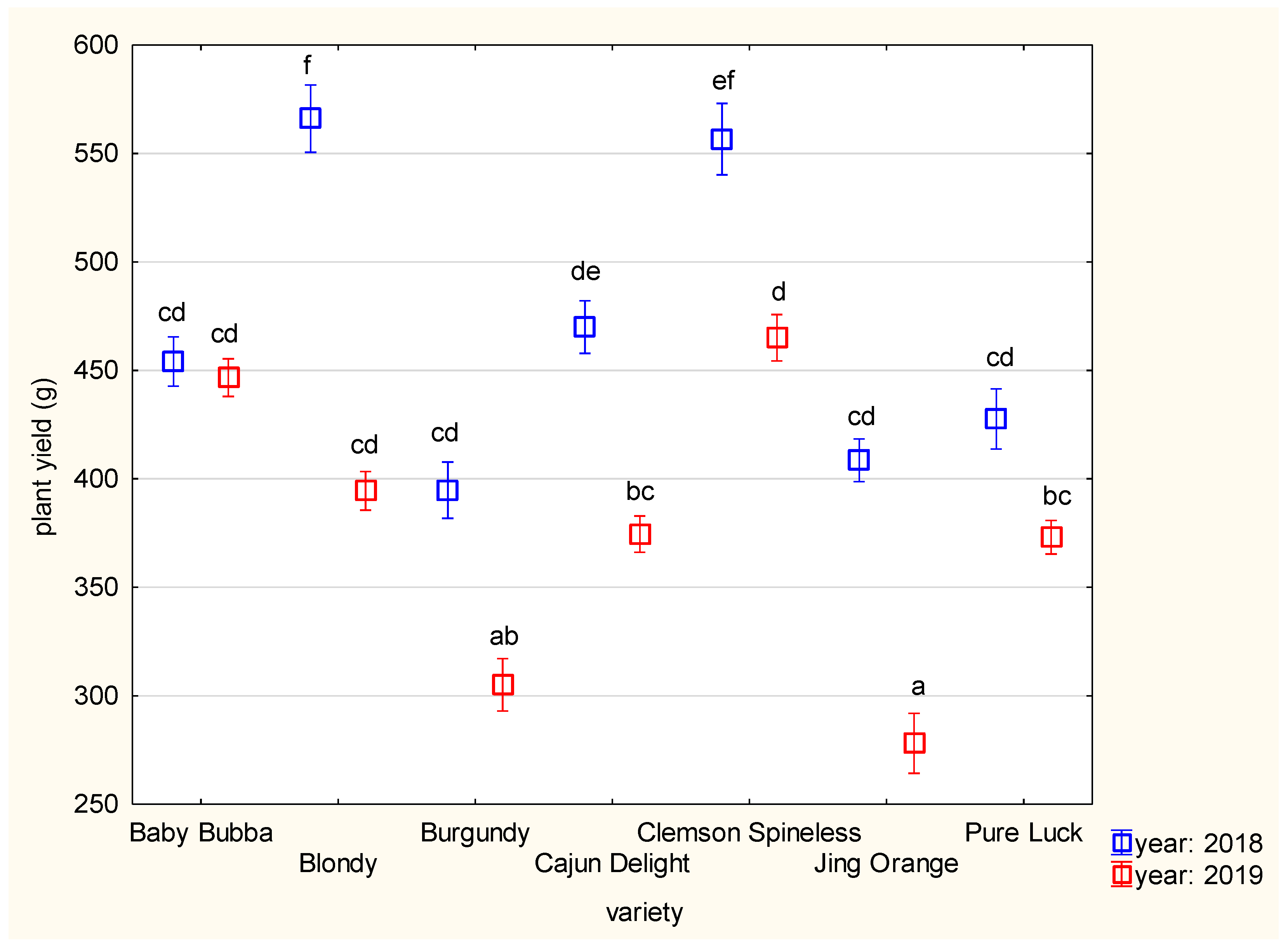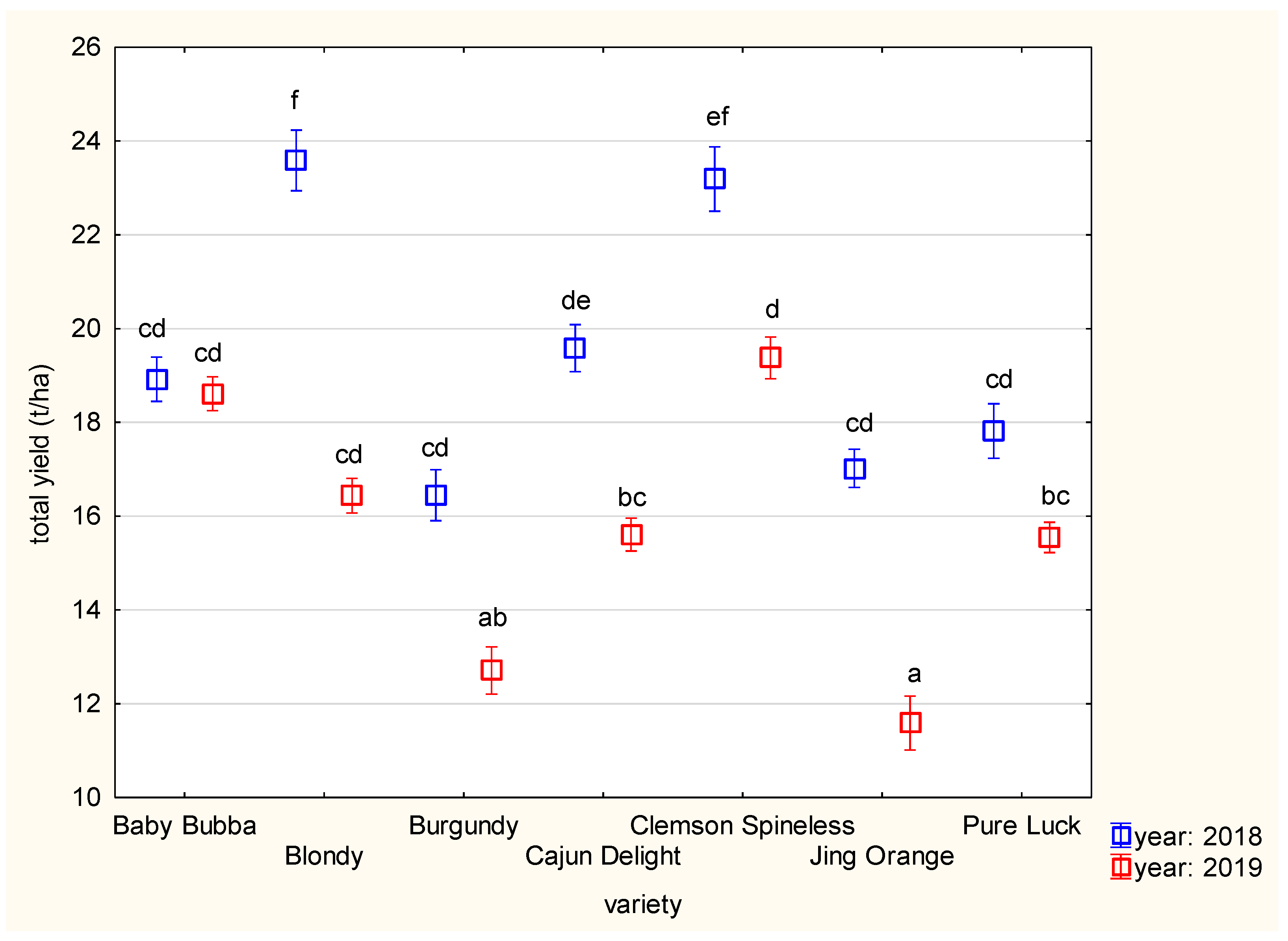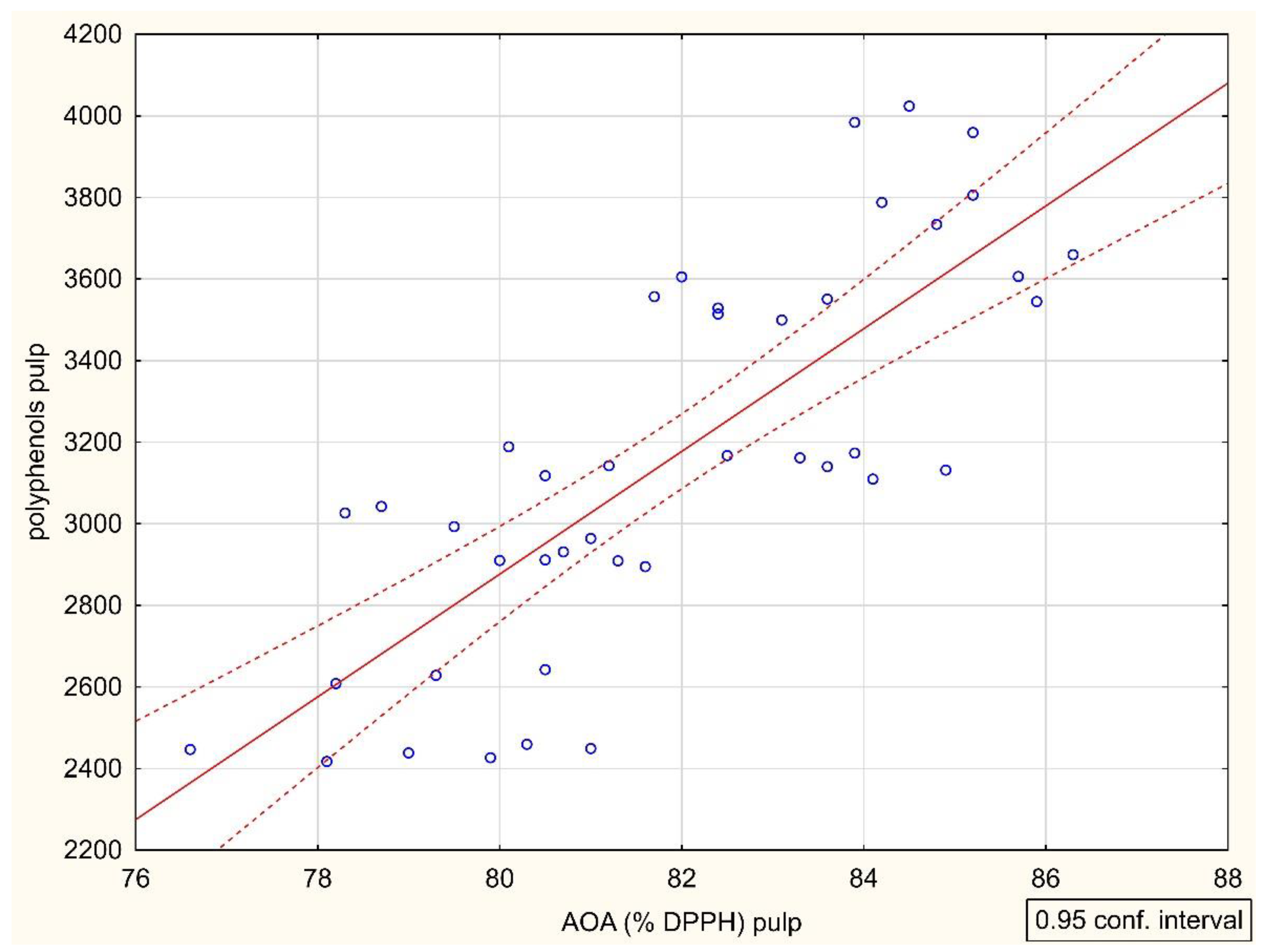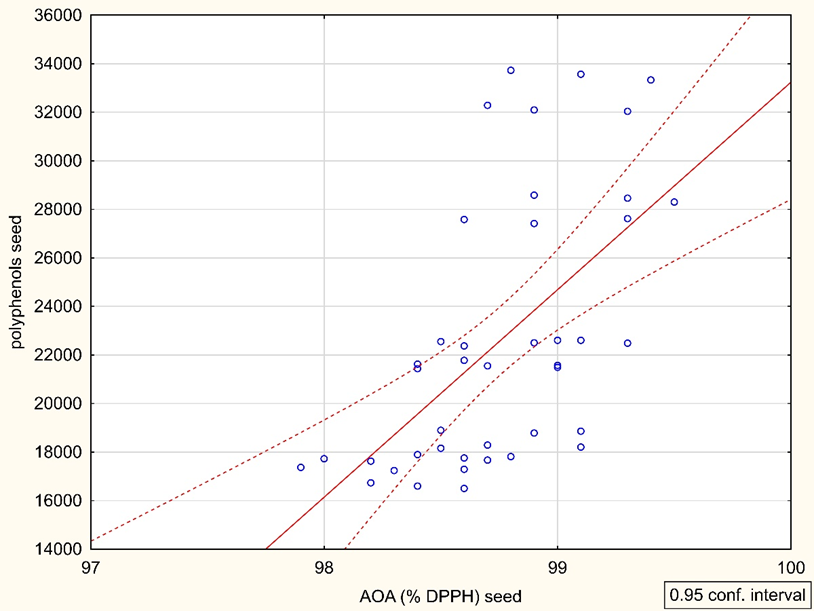Yield, Antioxidant Activity and Total Polyphenol Content of Okra Fruits Grown in Slovak Republic
Abstract
1. Introduction
2. Materials and Methods
2.1. Experiment Locality
2.2. Fertilization
2.3. Plant Material
2.4. Planting, Harvest and Sample Preparation
2.5. Determination of Antioxidant Activity
2.6. Determination of Total Polyphenol Content
2.7. Statistical Analysis
3. Results and Discussion
3.1. Average Weight of Fruits
3.2. Yield per Plant and Hectare
3.3. Antioxidant Activity
3.4. Total Polyphenol Content
3.5. Correlation of AOA and TPC
4. Conclusions
Author Contributions
Funding
Data Availability Statement
Conflicts of Interest
References
- Chanchal, D.K.; Alok, S.; Kumar, M.; Bijauliya, R.K.; Rashi, S.; Gupta, S. A brief review on Abelmoschus esculentus Linn. Okra. Int. J. Pharm. Sci. Res. 2018, 9, 58–66. [Google Scholar] [CrossRef]
- Jain, N.; Jain, R.; Jain, V.; Jain, S. A review on: Abelmoschus esculentus. Pharmacia 2012, 1, 84–89. Available online: https://pharmacia.ipsgwalior.org/artical/vol1_issue3_2.pdf (accessed on 11 July 2022).
- Kumar, A.; Kumar, P.; Nadendla, R. A review on: Abelmoschus esculentus (Okra). Int. Res. J. Pharm. Appl. Sci. 2013, 3, 129–132. [Google Scholar]
- Faostat (Food and Agriculture Organization of the United Nations). Available online: https://www.fao.org/faostat/en/#data/QCL/visualize (accessed on 11 July 2022).
- Meravá, E. Fruits and Vegetables; National Agricultural and Food Centre, Research Institute of Agriculture and Food Economics: Bratislava, Slovakia, 2021; pp. 54–72. (In Slovak) [Google Scholar]
- Elkhalifa, A.E.O.; Alshammari, E.; Adnan, M.; Alcantara, J.C.; Awadelkareem, A.M.; Eltoum, N.E.; Mehmood, K.; Panda, B.P.; Ashraf, S.A. Okra (Abelmoschus esculentus) as a Potential Dietary Medicine with Nutraceutical Importance for Sustainable Health Applications. Molecules 2021, 26, 696. [Google Scholar] [CrossRef]
- Xia, F.; Zhong, Y.; Li, M.; Chang, Q.; Liao, Y.; Liu, X.; Pan, R. Antioxidant and Anti-Fatigue Constituents of Okra. Nutrients 2015, 26, 8846–8858. [Google Scholar] [CrossRef]
- Ying, L.; Jingyi, Q.; Junyun, L.; Wen, Q.; Qingying, L.; Qing, Z.; Dingtao, W.; Derong, L.; Suqing, L.; Hongmin, D.; et al. Okra in Food Field: Nutritional Value, Health Benefits and Effects of Processing Methods on Quality. Food Rev. Int. 2019, 37, 67–90. [Google Scholar] [CrossRef]
- Al-Kanani, E.A.S.; Al-Hilifi, S.A.H.; Al-Kareem, A.H. The nutritional composition and vitamin E of three Iraqi okra (Abelmoschus esculentus L.) seeds oil. IOP Conf. Ser. Earth Environ. Sci. 2019, 388, 012058. [Google Scholar] [CrossRef]
- Graham, J.O.; Agbenorhevi, J.K.; Kpodo, F.M. Total Phenol Content and Antioxidant Activity of Okra Seeds from Different Genotypes. Am. J. Clin. Nutr. 2017, 5, 90–94. [Google Scholar] [CrossRef]
- Wu, D.-T.; Nie, X.-R.; Shen, D.-D.; Li, H.-Y.; Zhao, L.; Zhang, Q.; Lin, D.-R.; Qin, W. Phenolic Compounds, Antioxidant Activities, and Inhibitory Effects on Digestive Enzymes of Different Cultivars of Okra (Abelmoschus esculentus). Molecules 2020, 25, 1276. [Google Scholar] [CrossRef]
- Platzer, M.; Kiese, S.; Tybussek, T.; Herfellner, T.; Schneider, F.; Schweiggert-Weisz, U.; Eisner, P. Radical Scavenging Mechanisms of Phenolic Compounds: A Quantitative Structure-Property Relationship (QSPR) Study. Front. Nutr. 2022, 9, 882458. [Google Scholar] [CrossRef] [PubMed]
- Pourezza, N. Phenolic Compounds as Potential Antioxidant. Nat. Pharm. Prod. 2013, 8, 149–150. [Google Scholar] [CrossRef] [PubMed]
- San Miguel-Chávez, R. Phenolic Antioxidant Capacity: A Review of the State of the Art. In Phenolic Compounds—Biological Activity, 1st ed.; Soto-Hernández, M., Palma-Tenango, M., García-Mateos, R., Eds.; Intech Open: London, UK, 2017; pp. 59–74. [Google Scholar] [CrossRef]
- Kiokias, S.; Proestos, C.; Oreopoulou, V. Phenolic Acids of Plant Origin-A Review on Their Antioxidant Activity In Vitro (O/W Emulsion Systems) Along with Their in Vivo Health Biochemical Properties. Foods 2020, 9, 534. [Google Scholar] [CrossRef]
- Ozcan, T.; Akpınar, A.; Yilmaz-Ersan, L.; Delikanli Kiyak, B. Phenolics in Human Health. Int. J. Chem. Eng. 2014, 5, 393–396. [Google Scholar] [CrossRef]
- Fernandez-Lazaro, C.I.; Martínez-González, M.Á.; Aguilera-Buenosvinos, I.; Gea, A.; Ruiz-Canela, M.; Romanos-Nanclares, A.; Toledo, E. Dietary Antioxidant Vitamins and Minerals and Breast Cancer Risk: Prospective Results from the SUN Cohort. Antioxidants 2021, 10, 340. [Google Scholar] [CrossRef] [PubMed]
- Briguglio, G.; Costa, C.; Pollicino, M.; Giambò, F.; Catania, S.; Fenga, C. Polyphenols in cancer prevention: New insights (Review). Int. J. Funct. Nutr. 2020, 1, 9. [Google Scholar] [CrossRef]
- Mirmiran, P.; Hosseini-Esfahani, F.; Esfandiar, Z.; Hosseinpour-Niazi, S.; Azizi, F. Associations between dietary antioxidant intakes and cardiovascular disease. Sci. Rep. 2022, 12, 1504. [Google Scholar] [CrossRef]
- Zhou, D.-D.; Luo, M.; Shang, A.; Mao, Q.-Q.; Li, B.-Y.; Gan, R.-Y.; Li, H.-B. Antioxidant Food Components for the Prevention and Treatment of Cardiovascular Diseases: Effects, Mechanisms, and Clinical Studies. Oxid. Med. Cell. Longev. 2021, 17, 355. [Google Scholar] [CrossRef]
- Caruso, G.; Pokluda, R.; Sękara, A.; Kalisz, A.; Jezdinský, A.; Kopta, T.; Grabowska, A. Agricultural practices, biology and quality of eggplant cultivated in Central Europe. A review. Hort. Sci. 2017, 44, 201–212. [Google Scholar] [CrossRef]
- Benchasri, S. Okra (Abelmoschus esculentus (L.) Moench) as a Valuable Vegetable of the World. Ratar. Povrt. 2012, 49, 105–112. [Google Scholar] [CrossRef]
- Dantas, T.L.; Alonso Buriti, F.C.; Florentino, E.R. Okra (Abelmoschus esculentus L.) as a Potential Functional Food Source of Mucilage and Bioactive Compounds with Technological Applications and Health Benefits. Plants 2021, 10, 1683. [Google Scholar] [CrossRef] [PubMed]
- Botanical Garden, Slovak University of Agriculture in Nitra. Available online: https://bz.uniag.sk/sk/charakteristika-uzemia-bz (accessed on 14 July 2022).
- Polláková, N.; Šimanský, V. Physical properties of urban soil in the campus of Slovak University of Agriculture Nitra. Acta Fytotechn. Zootech. 2015, 18, 30–35. [Google Scholar] [CrossRef][Green Version]
- Brand-Williams, W.; Cuvelier, M.E.; Berset, C. Use of a free radical method to evaluate antioxidant activity. LWT-Food Sci. Technol. 1995, 28, 25–30. [Google Scholar] [CrossRef]
- Lachman, J.; Havrland, B.; Hejtmánková, A.; Fernández, E.C.; Pivec, V. Content of polyphenolic antioxidants and phenol carboxylic acids in selected parts of yacon. Sci. Agric. Bohem. 2005, 36, 49–54. [Google Scholar]
- Maldonado-Peralta, R.; Rojas-García, A.R.; Romero-Bautista, A.; Maldonado-Peralta, M.Á.; Salinas-Vargas, D.; Hernández-Castro, E. Morphological characteristics of okra fruits [Abelmoschus esculentus (L.) Moench.] cultivated in the dry tropic. Agro Product. 2021, 14, 73–77. [Google Scholar] [CrossRef]
- Rahman, K.; Waseem, K.; Kashif, M.; Jilani, M.S.; Kiran, M.; Ghazanfarullah; Mamoon-Ur-Rashid, M. Performance of different okra (Abelmoschus esculentus L.) cultivars under the agro-climatic conditions of Dera Ismail Khan. Pak. J. Sci. 2012, 64, 316–319. [Google Scholar]
- Meher, R.; Mandal, J.; Mohanta, S. Performance of okra [Abelmoschus esculentus (L.) Moench] cultivars under Red and Laterite Zone of West Bengal. J. Crop Weed 2016, 12, 142–144. [Google Scholar]
- Atallah, S.Y. Performance of Five Okra Cultivars Sown on Different Dates under Assiut Environmental Condition. Assiut J. Agric. Sci. 2016, 47, 217–224. [Google Scholar] [CrossRef]
- Ashraf, A.T.M.H.; Rahman, M.M.; Hossain, M.M.; Sarker, U. Performance Evaluation of Some Selected Okra Genotypes. Int. J. Plant Soil Sci. 2020, 32, 13–20. [Google Scholar] [CrossRef]
- Omotoso, S.O.; Johnson, O.Y. Growth and Yield of Two Varieties of Okra (Abelmoschus esculentus (L). Moench) as affected by Potassium Fertilizer Sources. J. Biol. Agric. Healthc. 2015, 5, 98–104. [Google Scholar]
- Maga, T.J.; Kortse, P.A.; Tsesar, T.K. Cultivars for growth and yield under the Southern Guinea savannah agro-ecological zone. In Crop Science Society of Nigeria: Second National Annual Conference Proceedings; Crop Science Society in Nigeria: Nsukka, Nigeria, 2015; pp. 140–145. [Google Scholar]
- Temam, N.; Mohamed, W.; Aklilu, S. Agro morphological Characterization and Evaluation of Okra [Abelmoschus esculentus (L.) Moench] Genotypes for Yield and Other Variability Components at Melkassa, Central Ethiopia. MOJ Eco Environ. Sci. 2020, 5, 80–87. [Google Scholar] [CrossRef]
- Maurya, R.P.; Bailey, J.A.; Chandler, J.S.A. Impact of plant spacing and picking interval on the growth, fruit quality and yield of okra (Abelmoschus esculentus (L.) Moench). Am. J. Agric. For. 2013, 1, 48–54. [Google Scholar] [CrossRef][Green Version]
- Agba, O.A.; Mbah, B.N.; Asiegbu, J.E.; Adinya, I.B. Effects of spacing on the growth and yield of Okra (Abelmochus esculentus) L. Moench in Obubra, Cross River state. Glob. J. Agric. Sci. 2011, 10, 57–61. [Google Scholar]
- Dash, P.K.; Rabbani, G.; Mondal, M.F. Effect of variety and planting date on the growth and yield of okra. Int. J. Biosci. 2013, 3, 123–131. [Google Scholar] [CrossRef]
- Hayati, P.K.D.; Mandwi, M.Y.; Martinsyah, R.H.; Sutoyo, S. Fruit picking time and fruit characteristics of the F2population of local okra [Abelmoschus esculentus [L.]Moench] crosses with introduced variety. IOP Conf. Ser. Earth Environ. Sci. 2021, 741, 012008. [Google Scholar] [CrossRef]
- Olivera, D.F.; Mugridge, A.; Chaves, A.R.; Mascheroni, R.H.; Viña, S.Z. Quality Attributes of Okra (Abelmoschus esculentus L. Moench) Pods as Affected by Cultivar and Fruit Size. J. Food Res. 2012, 1, 224–235. [Google Scholar] [CrossRef]
- Firoz, Z.A.; Islam, M.A.; Mohiuddin, M.; Rahman, M.M. Yield and yield attributes of okra as influenced by planting time and plant spacing in Hill slope condition. Progress. Agric. 2007, 18, 67–73. [Google Scholar] [CrossRef]
- Shahid, M.; Rehman, A.; Malik, A.A.; Zakaria, M.S. Effect of Sowing Dates on the Yield and Seed Production of Okra Cultivars in Mansehra. J. Biol. Agric. Health. 2015, 5, 172–177. [Google Scholar] [CrossRef]
- Singh, H.K.; Singh, K.M.; Veraj, M. Growth and Yield Performance of Okra [Abelmoschus esculentus (L.) Moench] Varieties on Farmer’s Field. Int. J. Curr. Microbiol. Appl. Sci. 2018, 7, 1411–1417. [Google Scholar]
- Oraye, C.D.; Caisip, R.E.; Mateo, J.M.C.; Maghirang, R.G. Okra variety trial for yield, fruit and nutritional quality. Philipp. J. Crop. Sci. 2019, 44, 137. [Google Scholar]
- Gudugi, I.A.S. Effect of cow dung and variety on the growth and yield of Okra (Abelmoschus esculentus (L.). Eur. J. Exp. Biol. 2013, 3, 495–498. [Google Scholar]
- Mateus, R. Evaluation of Varieties and Cultural Practices of Okra (Abelmoschus Esculentus) for Production in Massachusetts. Master’s Theses, University of Massachusetts, Amherst, MA, USA, September 2011. [Google Scholar]
- Ijoyah, M.O.; Dzer, D.M. Yield Performance of Okra (Abelmoschus esculentus L. Moench) and Maize (Zea mays L.) as Affected by Time of Planting Maize in Makurdi, Nigeria. Int. Sch. Res. Not. 2012, 2012, 485810. [Google Scholar] [CrossRef][Green Version]
- Dhankhar, S.K.; Deswal, D.P.; Singh, S. Impact of weather variables on yield and yield attributes in Okra under different growing environments. J. Agrometeorol. 2012, 14, 54–56. [Google Scholar] [CrossRef]
- Adekiya, A.O.; Ejue, W.S.; Olayanju, A.; Dunsin, O.; Aboyeji, C.M.; Aremu, C.; Adegbite, K.; Akinpelu, O. Different organic manure sources and NPK fertilizer on soil chemical properties, growth, yield and quality of okra. Sci. Rep. 2020, 10, 16083. [Google Scholar] [CrossRef]
- Caballero, B. Encyclopedia of Human Nutrition, 3rd ed.; Elsevier B.V.: Amsterdam, The Netherlands, 2013; pp. 88–99. [Google Scholar]
- Sing, P.; Chauhan, V.; Tiwari, B.K.; Chauhan, S.S.; Simon, S.; Bilal, S.; Abidi, A.B. An overview on okra (Abelmoschus esculentus) and its importance as a nutritive vegetable in the world. Int. J. Pharm. Bio. Sci. 2014, 4, 227–233. [Google Scholar]
- Manzoor, M.; Anwar, F.; Saari, N.; Ashraf, M. Variations of antioxidant characteristics and mineral contents in pulp and peel of different apple (Malus domestica Borkh.) cultivars from Pakistan. Molecules 2012, 17, 390–407. [Google Scholar] [CrossRef]
- Manzoor, M.; Anwar, F.; Bhatti, I.A.; Jamil, A. Variation of phenolics and antioxidant activity between peel and pulp parts of pear (Pyrus communis L.) fruit. Pak. J. Bot. 2013, 45, 1521–1525. [Google Scholar]
- Baek, S.; Shin, Y. Physicochemical qualities, antioxidant compounds, and activities of six mini paprika cultivars. Korean J. Food Sci. Technol. 2020, 52, 377–384. [Google Scholar] [CrossRef]
- Faisal, H.; Handayani, S. Comparison of Antioxidant Activity of Ethanol Extract of Fruit and Okra Leaves (Abelmoschus esculentus L. Moench) by DPPH and ABTS Methods. Ind. J. Pharm. Clin. Res. 2019, 2, 6–13. [Google Scholar] [CrossRef]
- Nuramalia, D.R.; Damayanthi, E. Effect of green okra and strawberry ratio on antioxidant activity, total phenolic content, and organoleptic properties of jelly drink. IOP Conf. Ser. Earth Environ. Sci. 2018, 196, 012005. [Google Scholar] [CrossRef]
- Adelakun, O.E.; Oyelade, O.J.; Ade-Omowaye, B.I.; Adeyemi, I.A.; Van de Venter, M.; Koekemoer, T.C. Influence of pre-treatment on yield chemical and antioxidant properties of a Nigerian okra seed (Abelmoschus esculentus Moench) flour. Food Chem. Toxicol. 2009, 47, 657–661. [Google Scholar] [CrossRef] [PubMed]
- Petropoulos, S.; Fernandes, Â.; Barros, L.; Ferreira, I.C.F.R. Chemical composition, nutritional value and antioxidant properties of Mediterranean okra genotypes in relation to harvest stage. Food Chem. 2018, 242, 466–474. [Google Scholar] [CrossRef]
- Khomsug, P.; Thongjaroe, W.; Pakdeenaro, N.; Suttajit, M.; Chantirati, P. Antioxidative activities and phenolic content of extracts from okra (Abelmoschus esculentus L.). Res. J. Biol. Sci. 2010, 5, 310–313. [Google Scholar] [CrossRef]
- Karunasiri, M.G.A.N.; Ravimannan, N.; Sevvel, P. Antioxidant activity in selected fresh vegetables in Jaffna. Vingnanam J. Sci. 2019, 14, 23–26. [Google Scholar] [CrossRef]
- Romdhane, M.H.; Chahdoura, H.; Barros, L.; Dias, M.I.; Corrêa, R.C.G.; Morales, P.; Ciudad-Mulero, M.; Flamini, G.; Majdoub, H.; Ferreira, I.C.F.R. Chemical Composition, Nutritional Value, and Biological Evaluation of Tunisian Okra Pods (Abelmoschus esculentus L. Moench). Molecules 2020, 25, 4739. [Google Scholar] [CrossRef]
- Adetuyi, F.O.; Ibrahim, T.A. Effect of Fermentation Time on the Phenolic, Flavonoid and Vitamin C Contents and Antioxidant Activities of Okra (Abelmoschus esculentus) Seeds. Niger. Food J. 2014, 32, 128–137. [Google Scholar] [CrossRef]
- Chao, P.-Y.; Lin, S.-Y.; Lin, K.-H.; Liu, Y.-F.; Hsu, J.-I.; Yang, C.-M.; Lai, J.-Y. Antioxidant Activity in Extracts of 27 Indigenous Taiwanese Vegetables. Nutrients 2014, 6, 2115–2130. [Google Scholar] [CrossRef]
- Ahmed, B.T.; Kumar, S.A. Antioxidant and antidiabetic properties of Abelmoschus esculentus extract—An in vitro assay. Res. J. Biotechnol. 2016, 11, 34–41. [Google Scholar]
- Siddique, M.S.; Ashraf, A.; Hayat, S.; Aslam, B.; Fakhar-e-Alam, M.; Muzammil, S.; Atif, M.; Shahid, M.; Shafeeq, S.; Afzal, M.; et al. Antidiabetic and antioxidant potentials of Abelmoschus esculentus: In vitro combined with molecular docking approach. J. Saudi Chem. Soc. 2022, 26, 101418. [Google Scholar] [CrossRef]
- Ahiakpa, J.K.; Quartey, E.K.; Amoatey, H.M.; Klu, G.Y.P.; Achel, D.G.; Achoribo, E.; Agbenyegah, S. Total flavonoid, phenolic contents and antioxidant scavenging activity in 25 accessions of okra (Abelmoschus spp L.). Afr. J. Food Sci. Technol. 2013, 45, 129–135. Available online: https://www.interesjournals.org/articles/total-flavonoid-phenolic-contents-and-antioxidantscavenging-activity-in-25-accessions-of-okraabelmoschus-spp-l.pdf (accessed on 11 July 2022).
- Xu, K.; Guo, M.; Roman, L.; Pico, J.; Martinez, M.M. Okra seed and seedless pod: Comparative study of their phenolics and carbohydrate fractions and their impact on bread-making. Food Chem. 2020, 317, 126387. [Google Scholar] [CrossRef]
- Jiang, N.; Liu, C.; Li, D.; Zhang, Z.; Liu, C.; Wang, D.; Niu, L.; Zhang, M. Evaluation of freeze drying combined with microwave vacuum drying for functional okra snacks: Antioxidant properties, sensory quality, and energy consumption. LWT-Food Sci. Technol. 2017, 82, 216–226. [Google Scholar] [CrossRef]
- Sarwar, S.; Akram, N.A.; Saleem, M.H.; Zafar, S.; Alghanem, S.M.; Abualreesh, M.H.; Alatawi, A.; Ali, S. Spatial variations in the biochemical potential of okra [Abelmoschus esculentus L. (Moench)] leaf and fruit under field conditions. PLoS ONE 2022, 7, e0259520. [Google Scholar] [CrossRef]
- Hu, L.; Guo, J.; Zhu, X.; Liu, R.; Wu, T.; Sui, W.; Zhang, M. Effect of steam explosion on nutritional composition and antioxidative activities of okra seed and its application in gluten-free cookies. Food Sci. Nutr. 2020, 8, 4409–4421. [Google Scholar] [CrossRef]
- Jeon, S.H.; Cho, Y.S.; Rho, I.R. Evaluation of bioactive compounds in different tissues of sprouting okra. Hortic. Environ. Biotechnol. 2017, 58, 514–521. [Google Scholar] [CrossRef]
- Abouel-Yazeed, A.M. Incorporation of Okra Seeds Powder to Employ in some Foodstuffs Based on its Physical, Chemical and Sensorial Evaluation. J. Food Dairy Sci. 2019, 10, 231–236. [Google Scholar] [CrossRef]
- Phornvillay, S.; Prongprasert, N.; Wongs-Aree, C.; Uthairatanakij, A.; Srilaong, V. Physio-biochemical Responses of Okra (Abelmoschus esculentus) to Oxidative Stress Under Low Temperature Storage. Hort. J. 2020, 89, 69–77. [Google Scholar] [CrossRef]
- Arapitsas, P. Identification and quantification of polyphenolic compounds from okra seeds and skins. Food Chem. 2008, 110, 1041–1045. [Google Scholar] [CrossRef]
- Bayili, R.G.; Abdoul-Latif, F.; Kone, O.H.; Diao, M.; Bassole, I.H.N.; Dicko, M.H. Phenolic compounds and antioxidant activities in some fruits and vegetables from Burkina Faso. Afr. J. Biotechnol. 2011, 10, 13543–13547. [Google Scholar] [CrossRef]
- Alam, M.A.; Hafizuddin, A.A.; Gobilik, J.; Mijin, S.; Khandaker, M.M. Evaluation of best quality okra parental lines based on morpho-physiological and nutritional attributes. Bulg. J. Agric. Sci. 2021, 27, 1127–1135. [Google Scholar]
- Adetuyi, F.O.; Osagie, A.U.; Adekunle, A.T. Nutrient, antinutrient, mineral and zinc bioavailability of okra Abelmoschus esculentus (L) Moench Variety. Am. J. Food Nutr. 2011, 1, 49–54. [Google Scholar] [CrossRef]





| Month | 2018 | 2019 | ||
|---|---|---|---|---|
| T (°C) | P (mm) | T (°C) | P (mm) | |
| January | −2.3 N | 49.7 VW | 2.4 VH | 50 VW |
| February | 3.2 H | 21.8 D | −0.9 C | 27 N |
| March | 8.1 VH | 15.6 VD | 3.4 C | 36 N |
| April | 9.4 N | 21.4 D | 15.4 EH | 16 VD |
| May | 9.3 EC | 134.8 EW | 18.8 VH | 29 VD |
| June | 18.7 N | 29.0 VD | 20.7 H | 44 D |
| July | 21.9 H | 21.0 VD | 21.7 H | 13 VD |
| August | 22.3 VH | 83.7 VW | 22.5 VH | 3 ED |
| September | 16.2 N | 60.3 W | 16.4 N | 55 W |
| October | 12.0 H | 15.0 VD | 11.9 N | 14 VD |
| November | 8.4 VH | 88.8 VW | 3.9 N | 24 VD |
| December | 3.3 H | 45.1 N | −1.6 C | 58 W |
| Total | - | 586.2 | - | 369 |
| Mean | 10.9 | - | 11.2 | - |
| Year | pH/KCl | Nutrients (mg kg−1 of Soil) | Humus Content (%) | |||||
|---|---|---|---|---|---|---|---|---|
| Nmin | P | K | S | Ca | Mg | |||
| 2018 | 7.04 N | 6.4 L | 75.0 M | 368 H | 2.5 VL | 6350 H | 763.4 VH | 3.29 G |
| 2019 | 6.89 N | 13.0 M | 77.5 M | 495.0 VH | 5.0 L | 5200 H | 964.0 VH | 3.75 G |
| Source of Variance | AW | Y/P | Y/H | AOA Pulp | AOA Seed | TPC Pulp | TPC Seed |
|---|---|---|---|---|---|---|---|
| Cultivar | *** | *** | *** | *** | ** | *** | *** |
| Year | *** | *** | *** | *** | ** | *** | *** |
| Cultivar x Year | *** | *** | *** | NS | NS | *** | ** |
| Cultivar | Pulp | Seeds | ||
|---|---|---|---|---|
| 2018 | 2019 | 2018 | 2019 | |
| Baby Bubba | 494.64 ± 7.17 abc | 502.54 ± 3.47 abcd | 594.51 ± 2.12 abc | 597.54 ± 1.85 a |
| Blondy | 501.29 ± 3.47 abcd | 505.66 ± 2.86 bcd | 595.12 ± 2.15 a | 595.84 ± 1.90 a |
| Burgundy | 524.99 ± 4.09 ef | 536.00 ± 1.90 f | 598.55 ± 2.20 a | 600.36 ± 1.97 a |
| Cajun Delight | 502.54 ± 4.09 abcd | 511.48 ± 2.19 cde | 597.14 ± 1.81 a | 597.94 ± 1.92 a |
| Clemson Spineless | 485.71 ± 7.56 a | 491.53 ± 3.81 ab | 595.32 ± 1.21 a | 596.13 ± 1.85 a |
| Jing Orange | 517.71 ± 3.76 de | 527.07 ± 4.06 ef | 596.93 ± 1.85 a | 598.75 ± 2.12 a |
| Pure Luck | 519.0 ± 4.38 def | 528.31 ± 3.14 ef | 598.75 ± 1.75 a | 599.56 ± 1.82 a |
| Cultivar | Pulp | Seeds | ||
|---|---|---|---|---|
| 2018 | 2019 | 2018 | 2019 | |
| Baby Bubba | 2626.33 ± 17.17 b | 3149.63 ± 36.09 e | 17,301.82 ± 66.77 b | 18,218.79 ± 65.22 c |
| Blondy | 2455.13 ± 16.86 a | 2929.96 ± 34.63 c | 17,763.52 ± 118.36 bc | 18,846.22 ± 56.41 d |
| Burgundy | 3127.12 ± 15.87 de | 3603.19 ± 57.59 f | 27,538.64 ± 107.99 g | 28,446.71 ± 142.68 h |
| Cajun Delight | 2910.14 ± 11.18 c | 3563.59 ± 38.81 f | 21,493.01 ± 58.45 e | 22,552.80 ± 53.26 f |
| Clemson Spineless | 2434.12 ± 15.21 a | 3020.71 ± 24.98 cd | 16,612.60 ± 113.73 a | 17,730.79 ± 95.51 b |
| Jing Orange | 3521.38 ± 26.17 f | 3988.72 ± 32.74 h | 21,658.27 ± 108.77 e | 22,486,35 ± 118.07 f |
| Pure Luck | 3167.22 ± 5.90 e | 3775.65 ± 37.40 g | 32,140.08 ± 129.60 i | 33,539.09 ± 199.08 j |
Publisher’s Note: MDPI stays neutral with regard to jurisdictional claims in published maps and institutional affiliations. |
© 2022 by the authors. Licensee MDPI, Basel, Switzerland. This article is an open access article distributed under the terms and conditions of the Creative Commons Attribution (CC BY) license (https://creativecommons.org/licenses/by/4.0/).
Share and Cite
Fabianová, J.; Šlosár, M.; Kopta, T.; Vargová, A.; Timoracká, M.; Mezeyová, I.; Andrejiová, A. Yield, Antioxidant Activity and Total Polyphenol Content of Okra Fruits Grown in Slovak Republic. Horticulturae 2022, 8, 966. https://doi.org/10.3390/horticulturae8100966
Fabianová J, Šlosár M, Kopta T, Vargová A, Timoracká M, Mezeyová I, Andrejiová A. Yield, Antioxidant Activity and Total Polyphenol Content of Okra Fruits Grown in Slovak Republic. Horticulturae. 2022; 8(10):966. https://doi.org/10.3390/horticulturae8100966
Chicago/Turabian StyleFabianová, Júlia, Miroslav Šlosár, Tomáš Kopta, Andrea Vargová, Mária Timoracká, Ivana Mezeyová, and Alena Andrejiová. 2022. "Yield, Antioxidant Activity and Total Polyphenol Content of Okra Fruits Grown in Slovak Republic" Horticulturae 8, no. 10: 966. https://doi.org/10.3390/horticulturae8100966
APA StyleFabianová, J., Šlosár, M., Kopta, T., Vargová, A., Timoracká, M., Mezeyová, I., & Andrejiová, A. (2022). Yield, Antioxidant Activity and Total Polyphenol Content of Okra Fruits Grown in Slovak Republic. Horticulturae, 8(10), 966. https://doi.org/10.3390/horticulturae8100966







